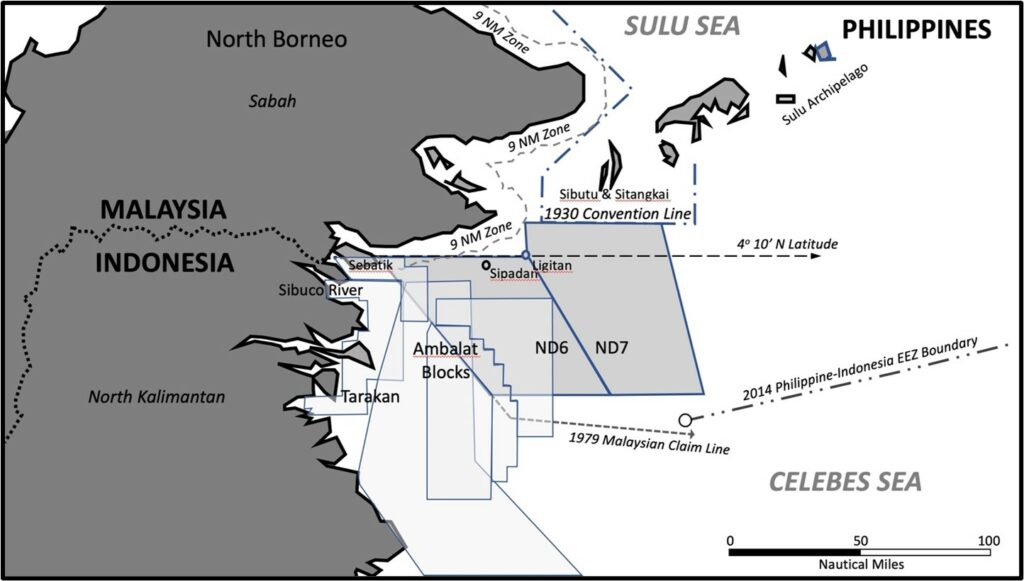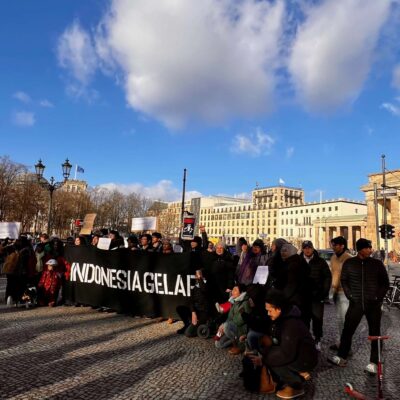The maritime and territorial disputes in the South China Sea may have attracted the most attention in recent years, but Southeast Asia’s fragmented geography and colonial history laid the foundation for numerous overlapping claims to limited ocean space. Many problem areas, such as those between Indonesia, Malaysia, Thailand, and Vietnam, have been settled or managed peacefully over the years but a few fester and occasionally spark tensions. These occur particularly in trilateral areas of convergence, such as the bordering sea areas in the Celebes (Sulawesi) Sea.
The Celebes (Sulawesi) Sea is the southern component of the Sulu-Celebes Large Marine Ecoregion, comprised of two resource-rich sea areas enclosed by the Philippines, Malaysia, and Indonesia. For the most part, the waters of the Celebes Sea have been divided between the Philippines and Indonesia through an Exclusive Economic Zone (EEZ) boundary agreement reached in 2014. This is expected to be followed by a continental shelf boundary agreement, negotiations for which were announced in 2021.
On the northwestern side of the Celebes, however, prospective maritime boundaries converge between three Southeast Asian nations, near where the northeastern tip of the Island of Borneo meets the southwestern islands of the Sulu Archipelago. The convergence is created primarily by the adjacency of the North Kalimantan and Sabah regions on the Island of Borneo, separated by a land border bisecting Sebatik Island, and the Sibutu and Sitangkai Islands of the Philippines about 90 nautical miles eastward. This is complicated by the fact that the Philippines has not officially dropped its claim to the portion of North Borneo. Although the Philippine claim is often referred to as the ‘Sabah claim,’ the area described by the 1878 Agreement does not actually encompass the entire territory of the present-day Malaysian State of Sabah. The Philippines clarified the scope of the claim in its attempt to intervene in the Case Concerning Sovereignty over Pulau Ligitan and Pulau Sipadan (Indonesia v. Malaysia), emphasising that ‘the Philippines is not claiming all of Sabah or contesting its political legitimacy. The Republic of the Philippines is claiming a piece of territory in North Borneo.
The resulting maritime and territorial disputes have been simmering since the 1960s, occasionally flaring into tensions but without resulting in violent confrontation. They may be categorised as two sets of distinct disputes, between Indonesia and Malaysia on one hand, and between the Philippines and Malaysia on the other.

Figure 1. Map of the northwestern corner of the Celebes (Sulawesi) Sea, where the Philippines, Malaysia, and Indonesia have unresolved territorial and maritime claims. Modified from Arsana 2014.
Indonesia-Malaysia disputes
The Indonesia-Malaysia disputes spring from differences over the interpretation of provisions concerning the boundary between the respective colonial possessions of the UK and Netherlands originally established by treaty in 1891. The boundary is specified to commence at 4° 10’ N latitude on the eastern coast of Borneo, proceeding westward toward the interior and eastward bisecting Sebatik Island; whether and how far the boundary then extended from the shore and further seaward into the Celebes became the bone of contention after Indonesia and Malaysia gained independence.
By 1969, a territorial dispute arose over the Sipadan and Ligitan islands located directly east and just a short distance south of the parallel, with Indonesia arguing that the colonial boundary extended seaward to allocate the two islands in its favor, while Malaysia contended that was neither intended nor put into practice by the parties. In 1998, the territorial dispute was taken to the International Court of Justice for adjudication. In 2002, the ICJ ruled against Indonesia and found that sovereignty over Sipadan and Ligitan Islands belonged to Malaysia on the basis of effectivités, or evidence of various acts of State power and authority relevant to a claim of title to territory.
Pending resolution of the territorial dispute, a related but distinct maritime dispute commenced when Indonesia began unilaterally exercising sovereign rights over the seabed east of Tarakan, North Kalimantan and south of 4° 10’ N latitude. This included the issuance of petroleum concession contracts for the Ambalat and Ambalat East blocks in 1999 and 2004 respectively; the blocks are located directly south of the Sipadan and Ligitan Islands. Indonesia’s issuance of contracts for these areas ignored Malaysia’s own unilateral claim to a portion of the seabed indicated by a map of its continental shelf published in 1979; this covered a considerable area adjacent to North Kalimantan. However, Malaysia did not take any action upon the Ambalat blocks until 2005, when it issued its own petroleum concession contracts, designated ND6 and ND7, that partly overlapped with the Indonesian contract areas. This led to tensions flaring in 2005 and 2009 on account of reports about naval and maritime law enforcement activities in the area, both sides’ insistence on their respective unilaterally-claimed sea zones, inflammatory media coverage, and the public outcries that followed. Fortunately, the political leadership on both sides managed to prevent further escalation.
The maritime dispute between Indonesia and Malaysia persists despite settlement of the territorial dispute regarding sovereignty over Sipadan and Ligitan Island, since common maritime boundaries have not been agreed upon. Both parties affirmed that they would pursue peaceful settlement of the maritime dispute through negotiations. However, in the absence of final agreement, petroleum concessionaires for the Ambalat blocks appear to be unwilling to carry out exploration, highlighting the petroleum industry’s need for absolute certainty of resource ownership and extreme sensitivity to political risks.
Philippines-Malaysia dispute
The Philippines-Malaysia dispute arises out of the former’s territorial claim based on an 1878 agreement between the Sultan of Sulu and Baron de Overbeck, subsequently confirmed in 1903. The 1878 agreement covers the northern coast of Borneo from the Pandassan River on the west to the Sibuco River on the east and all coastal settlements and islands within nine miles from the coast. The area was eventually transferred to the British North Borneo Company, which administered it until it became a British Crown Colony in 1946. In 1962, the Philippines announced that it was making a claim of ‘sovereignty, jurisdiction, and proprietary ownership’ over the area as successor-in-interest of the Sultan of Sulu. The Philippines argued that the 1878 agreement merely constituted a lease over the Sultan’s domain, which the Sultan had legally ceded to the Philippines. The United Kingdom and Malaysia rejected the Philippine claim, arguing that the 1878 agreement was a permanent cession, followed by events which saw the Sultanate abolished as a political and sovereign entity and ultimately superseded by the self-determination of the inhabitants through their assent to the formation of the State of Sabah and membership in the Federation of Malaysia upon its establishment in 1963.
Examination of the provisions of the 1878 and 1903 agreements show that the part of the Philippine claim facing the Celebes Sea includes the northeastern tip of North Borneo to as far south as the Sibuco River, which is actually located about five nautical miles inside Indonesia, or south of the Malaysia-Indonesia border drawn in 1891. The Philippines has never asserted its claim to this small portion of land against Indonesia even though technically it is included in the 1878 and 1903 agreements. The claim apparently does not extend as far as the Sipadan and Ligitan Islands, which are about 20 nautical miles distant from the mainland. In its application for intervention in the case before the ICJ, the Philippines expressly stated that it did not intend to change the scope of the territorial dispute between Indonesia and Malaysia, and assured Indonesia that it had no territorial interest over the islands. It sought to intervene in the proceedings primarily ‘to preserve and safeguard the historical and legal rights’ of the Philippines arising from its claim, to the extent that [the] rights are affected, or may be affected,’ by the ICJ judgement.
The Philippine claim to the land territory which is part of the State of Sabah implies a claim to the adjacent sea areas, but this has never been officially articulated. The 1878 agreement includes all islands within nine nautical miles of the mainland coast, and it is not clear whether this means the Philippines will claim a territorial sea only up to that distance or up to the maximum of 12 nautical miles permitted under international law. The Philippines has not officially specified whether it also lays claim to other maritime zones in the Celebes but this may be implied from diplomatic notes concerning the coast of North Borneo facing the South China Sea. In its 2009 protest against the Vietnamese-Malaysian joint submission to a continental shelf in the southern portion of the South China Sea, it stated that the latter ‘overlap with that of the Philippines.’ In a separate protest to the Malaysian unilateral submission to a continental shelf further north, the Philippines invoked as a basis, among others, that ‘the Malaysian submission is projected from portions of North Borneo over which [the Philippines ] has never relinquished its sovereignty. Together, these seem to indicate that the Philippines may also claim any continental shelf areas attributable to the part of the coast of North Borneo that is subject to its territorial claim.
Adding to the uncertainty of the Philippines’ position is that it has not publicly protested the ND6 and ND7 petroleum concession contracts, and for quite some time has respected a de facto seabed boundary between it and Malaysia in both the Sulu and Celebes seas. This boundary is based on the 1930 Convention between the US and the United Kingdom separating the Island of North Borneo from the Philippine Islands. In practice, the governments of Malaysia and the Philippines respectively have avoided overlaps in adjacent petroleum concession contract areas. In 2006, the Philippines issued Service Contract No. 64 encompassing the entire area around Sibutu and Sitangkai Islands in the Sulu Sea; the southern boundary of the contract coincided with the boundary of the 1930 Convention, which also comprised the northern boundary of ND7. The contract expired in 2012 and does not appear to have been extended or renewed.
At some point in the future, the three neighbors will have to negotiate a trilateral boundary in this area, which must connect with an existing EEZ boundary agreed in 2014, and a prospective continental shelf boundary, between the Philippines and Indonesia. The western endpoint of the existing Philippine-Indonesian EEZ boundary is located at 3° 6’ 41” N and 119° 55’ 34” E, very close to Malaysia’s unilateral seabed boundary and approximately 90 nautical miles southeast of the Ambalat blocks. Assuming that EEZ and continental shelf boundaries are negotiated between Malaysia and Indonesia in the area around the Ambalat blocks, there may be room for a potential Philippine-Malaysian dispute over petroleum exploration in the area of Malaysia ND7 contract, should the Philippines decide to extend its seabed claims south beyond the 1930 US-UK Convention line. This is possible regardless of the fate of the Philippine claim to the adjacent land territory of the State of Sabah, on account of the configuration of the relevant coastlines.
Prospects for the future
The northwestern corner of the Celebes (Sulawesi) Sea is a confined geographic space where different territorial and maritime claims between three founding members of the Association of Southeast Asian Nations converge. Competing interests to land territories have been more clearly articulated and resolved between Indonesia and Malaysia but remain pending between Malaysia and the Philippines. The maritime zones emanating from these contested areas are likewise unsettled; while Malaysia and Indonesia have committed to continuing negotiations over them, the potential maritime disputes between Malaysia and the Philippines do not appear to have crystallised and remain open to future developments. Despite occasional tensions, it is a credit to the three nations that their differences have not escalated into open conflict. Lack of firm resolution, however, will probably make the tri-border area a source of friction, and already creates a barrier for the development of valuable marine resources such as offshore petroleum. In the near future, as living resources are stressed further by over-exploitation, the area may also be the venue of sharp fishery disputes between traditional and coastal communities. It would certainly be in the interests of the region for Indonesia, Malaysia, and the Philippines to find the common ground upon which they may settle these complicated territorial and maritime disputes.
This article is part of the ‘Blue Security’ project led by La Trobe Asia, University of Western Australia Defence and Security Institute, Griffith Asia Institute, UNSW Canberra and the Asia-Pacific Development, Diplomacy and Defence Dialogue (AP4D). Views expressed are solely of its author/s and not representative of the Maritime Exchange, the Australian Government, or any collaboration partner country government.
Image credit: Author.




